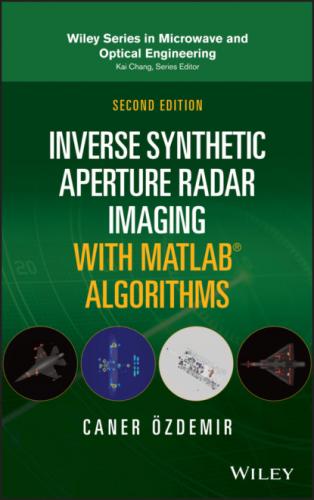2.6.4 Short Pulse
One of the simplest radar waveforms is the short pulse (or impulse) whose time duration is usually on the order of a few nanoseconds. As calculated in Eq. 2.54, the range resolution of a pulsed radar is equal to
(2.56)
where B is the frequency bandwidth of the pulse. According to the Fourier theory, the frequency bandwidth, B of a pulse is also inversely proportional to its pulse duration as
(2.57)
which means that the range resolution is proportional to its pulse duration as
Therefore, to have a good range resolution, the duration of a pulse has to be as small as possible. Common short pulse waveforms are rectangular pulse, single‐tone pulse, and single wavelet pulse of different forms. In Figure 2.16a, a rectangular pulse‐shape wave is shown, and the spectrum of this signal is plotted in Figure 2.16b. In the frequency domain, a sinc‐type pattern is obtained as expected.
Another common single‐pulse shape is a single sine signal as plotted in Figure 2.17. Since the time‐domain pulse is smoother when compared to the rectangular pulse (see Figure 2.17a), the spectrum widens, and sidelobe levels decrease as expected according to the Fourier theory as depicted in Figure 2.17b.
Another popular short‐duration waveform is called the wavelet signal. Wavelets are much smoother than the sine pulse; therefore, they provide less sidelobes in the frequency domain. In Figure 2.18a, a Mexican‐hat type wavelet whose mathematical function is given below is shown below:
(2.59)
Since this signal is much smoother than the previous short pulse waveforms that we have presented, the frequency extent of this wavelet is extremely broad. Therefore, it provides an ultrawide band (UWB) spectrum as most of the other short‐duration wavelets do as shown in Figure 2.18b.
While these short pulses are good for providing a wide spectrum, they are not practical in terms of providing sufficient energy. This is because of the fact that it is not possible to put great amount of power onto a very small pulse. To circumvent this problem, the pulse is modulated by altering the frequency as time continues to pass. The common practice is to use a chirp waveform to be able to put enough energy onto the pulse, as will be investigated next.
2.6.5 Chirp (LFM) Pulse
As explained in the previous paragraph, it will not be possible to use a sufficiently wide pulse and achieve a wide bandwidth. If a broadband spectrum is achieved with an unmodulated, or constant‐frequency pulse (as in Figure 2.19a), its time duration has to be quite small such that it may not be possible to put enough energy on it. A solution to this problem is to use a modulated pulse of sufficient duration such that this modulated waveform provides the required frequency bandwidth for the operation of radar.
Figure 2.16 A short‐duration rectangular pulse in (a) time domain, (b) frequency domain.
Figure 2.17 A short‐duration single‐frequency pulse in (a) time domain, (b) frequency domain.
Figure 2.18 A short‐duration Mexican‐hat pulse in (a) time domain, (b) frequency domain.
Figure 2.19 Comparison of the time‐domain pulse waveforms: (a) single‐tone pulse, (b) LFM (Chirp) pulse.
The common waveform is the LFM pulse, also known as the chirp pulse, whose waveform is shown in Figure 2.19b. In practice, this waveform is repeated in every TPR intervals for most common radar applications, especially for localization of targets in the range. TPR is called the pulse repetition interval (PRI) or pulse repetition period. The inverse of this interval gives the pulse repetition frequency (PRF), defined as
The mathematical expression of the upward chirp signal whose frequency is increasing as time passes along the pulse is given as
(2.61)
where n is an integer, τ is the pulse width, and K is the chirp rate. The instantaneous frequency of the pulse is fi(t) = fo + Kt. It is also possible to form another LFM pulse by decreasing the frequency along the pulse width as shown below:
(2.62)
For the downward chirp pulse, the instantaneous frequency is then equal to fi(t) = fo − Kt.
To demonstrate the broad spectrum of the LFM waveform, the FT of single‐tone and LFM pulse signals in Figure 2.19 is taken and plotted in Figure
